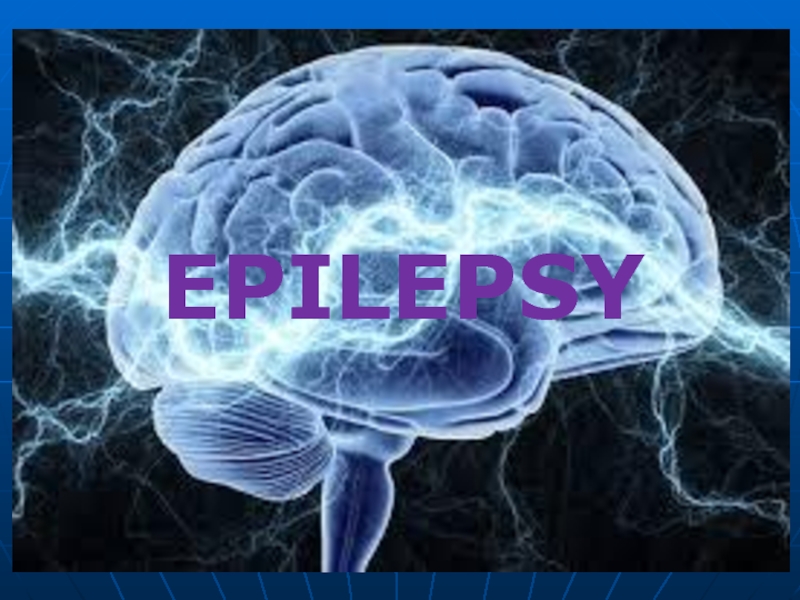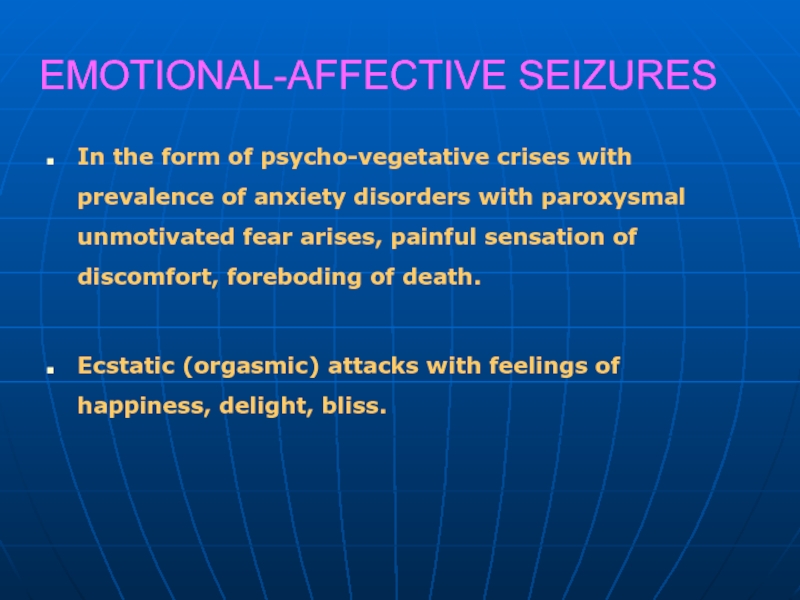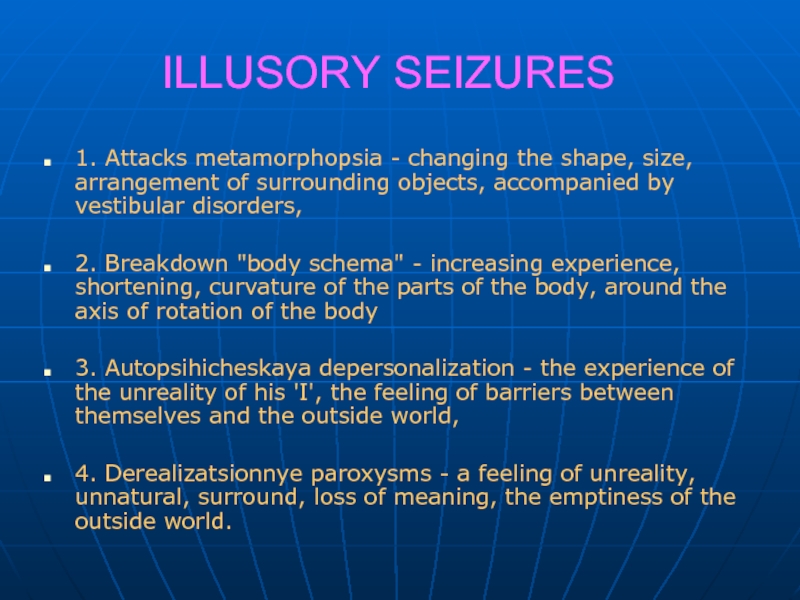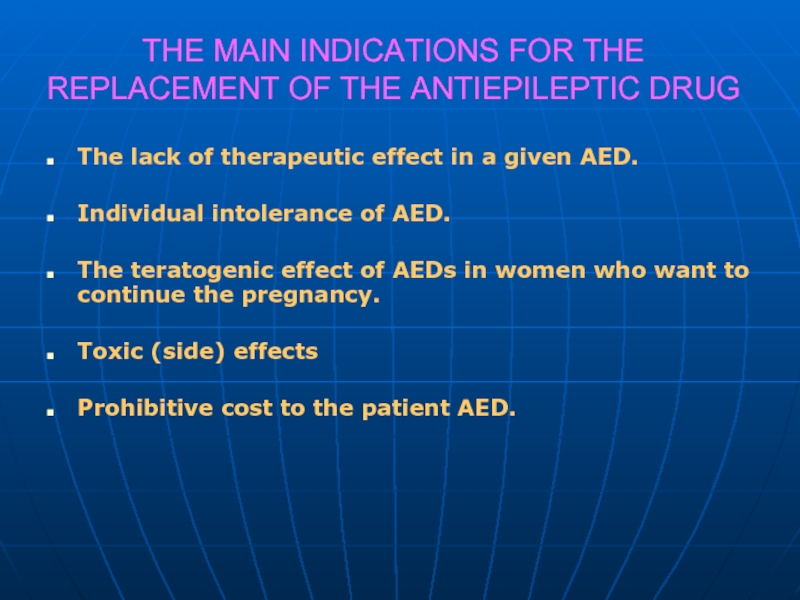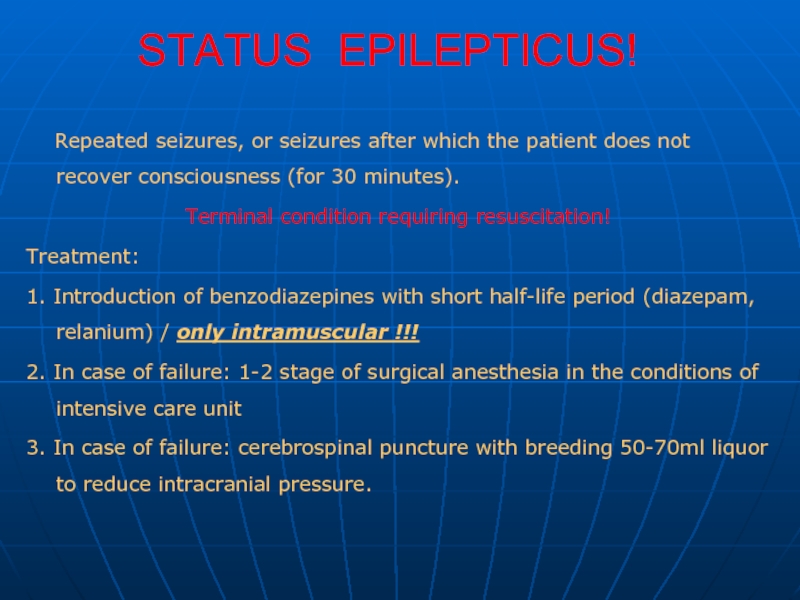- Главная
- Разное
- Дизайн
- Бизнес и предпринимательство
- Аналитика
- Образование
- Развлечения
- Красота и здоровье
- Финансы
- Государство
- Путешествия
- Спорт
- Недвижимость
- Армия
- Графика
- Культурология
- Еда и кулинария
- Лингвистика
- Английский язык
- Астрономия
- Алгебра
- Биология
- География
- Детские презентации
- Информатика
- История
- Литература
- Маркетинг
- Математика
- Медицина
- Менеджмент
- Музыка
- МХК
- Немецкий язык
- ОБЖ
- Обществознание
- Окружающий мир
- Педагогика
- Русский язык
- Технология
- Физика
- Философия
- Химия
- Шаблоны, картинки для презентаций
- Экология
- Экономика
- Юриспруденция
Personality disorders and behavior-related diseases, damage and dysfunction of the brain презентация
Содержание
- 1. Personality disorders and behavior-related diseases, damage and dysfunction of the brain
- 2. EPILEPSY
- 3. Epilepsy (definition) chronic brain disorder characterized by
- 4. Epidemiology of Seizures and Epilepsy
- 5. Relationship Between Age and Epilepsy Etiology.
- 6. ILAE Classification of Seizures. Partial (Focal)
- 7. Partial Seizures Simple - consciousness
- 8. Simple Partial Seizures: Sub classification
- 9. Partial/Generalized seizures – Sub classification
- 10. Complex Partial Seizures Impaired consciousness
- 11. Generalized Tonic-Clonic Seizures Aura Tonic
- 12. Secondarily Generalized Seizures Assumed or observed
- 13. Absence Seizures Brief (3-20
- 14. SYMPTOMS OF EPILEPTIC SEIZURES outbreak
- 15. NON-CONVULSIVE PAROXYSMS Aura - short-term
- 16. NON-CONVULSIVE PAROXYSMS Affective paroxysms. a) dysphoria
- 17. CHANGES IN PERSONALITY AND
- 18. EPILEPTIC PSYCHOSIS 1. Acute a)
- 19. PARTIAL AUTONOMIC-VISCERAL ATTACKS Epigastric seizures
- 20. IDEATORNOY SEIZURES 1. Abnormal amplification
- 21. EMOTIONAL-AFFECTIVE SEIZURES In the form of psycho-vegetative
- 22. ILLUSORY SEIZURES 1. Attacks
- 23. HALLUCINATORY SEIZURES 1.
- 24. ORGANIC EPILEPTICUS (CONCENTRIC), DEMENTIA 1. Deterioration of
- 25. ADDITIONAL METHODS OF DIAGNOSIS OF EPILEPSY
- 26. BASIC PRINCIPLES OF TREATMENT
- 27. BASIC PRINCIPLES OF TREATMENT
- 28. THE MAIN INDICATIONS FOR THE REPLACEMENT OF
- 29. BASIC DRUG OF TREATMENT PARTIAL
- 30. SITUATIONS THAT DO NOT REQUIRE
- 31. STATUS EPILEPTICUS! Repeated seizures, or
- 32. THANK YOU FOR ATTENTION!
Слайд 3Epilepsy
(definition)
chronic brain disorder characterized by repeated convulsive seizures or not, as
well as their equivalents, resulting from excessive neuronal discharges and are accompanied by a variety of neurological and psychopathological symptoms.
Слайд 4
Epidemiology of Seizures and Epilepsy
Seizures
Incidence: approximately 80/100,000 per year
Lifetime
prevalence: 9%
(1/3 - febrile convulsions)
Epilepsy
Incidence: approximately 30-57/100,000 per year
Lifetime incidence: 2-4%.
Point prevalence: 0.5-1%.
Increased in underdeveloped countries and in lower socioeconomic groups.
Epilepsy
Incidence: approximately 30-57/100,000 per year
Lifetime incidence: 2-4%.
Point prevalence: 0.5-1%.
Increased in underdeveloped countries and in lower socioeconomic groups.
Слайд 5
Relationship Between Age and Epilepsy Etiology.
Infancy/early childhood - most common congenital/prenatal
CNS insults.
Late childhood/early adulthood - most common idiopathic/genetic.
Adult/elderly - most symptomatic (i.e. trauma, ischemia, tumors, hemorrhage, degenerative diseases).
Late childhood/early adulthood - most common idiopathic/genetic.
Adult/elderly - most symptomatic (i.e. trauma, ischemia, tumors, hemorrhage, degenerative diseases).
Слайд 6ILAE Classification of Seizures.
Partial (Focal) Seizures:
Arise in a limited number
of cortical neurons within one hemisphere.
Generalized Seizures:
Appear to arise simultaneously in both hemispheres.
Unclassifiable Seizures
Generalized Seizures:
Appear to arise simultaneously in both hemispheres.
Unclassifiable Seizures
Слайд 7
Partial Seizures
Simple - consciousness preserved.
Complex - some impairment of consciousness.
Secondary generalized - development of generalized tonic-clonic activity.
Слайд 8
Simple Partial Seizures:
Sub classification
With motor symptoms/signs (e.g. Jacksonian).
With somatosensory
or special sensory symptoms (hallucinations/illusions).
With autonomic symptoms/signs.
With psychic symptoms.
With autonomic symptoms/signs.
With psychic symptoms.
Слайд 9Partial/Generalized seizures –
Sub classification
Idiopathic - Underlying brain is structurally and
functionally normal.
Usually onset during childhood/teenage and may remit.
Usually respond well to medication.
Likely have a genetic basis - ion channels.
Symptomatic - Seizures result from some identifiable structural/functional brain abnormality.
Uncommonly remit, and often incompletely controlled with medication.
Cryptogenic - Presumed to be symptomatic.
Usually onset during childhood/teenage and may remit.
Usually respond well to medication.
Likely have a genetic basis - ion channels.
Symptomatic - Seizures result from some identifiable structural/functional brain abnormality.
Uncommonly remit, and often incompletely controlled with medication.
Cryptogenic - Presumed to be symptomatic.
Слайд 10Complex Partial Seizures
Impaired consciousness
Clinical manifestations vary with site of origin
and degree of spread
Presence and nature of aura
Automatisms (oral, motor, vocal, complex)
Other motor activity
Duration (15 sec.—3 min.)
Presence and nature of aura
Automatisms (oral, motor, vocal, complex)
Other motor activity
Duration (15 sec.—3 min.)
Слайд 11Generalized Tonic-Clonic Seizures
Aura
Tonic Phase –
Sudden onset LOC with generalized
muscle rigidity with limb flexion/extension.
Often initial “tonic” cry.
Lasts approximately 30 sec.
Clonic Phase –
Generalized rhythmic jerking, gradually decreasing in frequency.
Post-ictal –
Stupor, confusion/agitation, lethargy.
Often initial “tonic” cry.
Lasts approximately 30 sec.
Clonic Phase –
Generalized rhythmic jerking, gradually decreasing in frequency.
Post-ictal –
Stupor, confusion/agitation, lethargy.
Слайд 12Secondarily Generalized Seizures
Assumed or observed to begin as simple and/or complex
partial seizures
Variable symmetry, intensity, and duration of tonic (stiffening) and clonic (jerking) phases
Usual duration 30-120 sec.
Post-ictal confusion, somnolence, with or without transient focal deficit
Variable symmetry, intensity, and duration of tonic (stiffening) and clonic (jerking) phases
Usual duration 30-120 sec.
Post-ictal confusion, somnolence, with or without transient focal deficit
Слайд 13
Absence Seizures
Brief (3-20 sec.) episodes of staring with unresponsiveness and amnesia.
Sudden onset and offset with no post-ictal confusion.
Provoked by hyperventilation.
Usually begin ages 4 - 14 years and resolve by 18 years.
May persist into adulthood - especially women.
EEG - “3 Hz spike & wave”.
Result from abnormal, hyper synchronous thalamo-cortical activity.
Слайд 14
SYMPTOMS OF EPILEPTIC SEIZURES
outbreak
short duration (from fractions of a second to
10 minutes)
spontaneous termination
stereotype
identity at this point in the disease
complete amnesia surrounding events
spontaneous termination
stereotype
identity at this point in the disease
complete amnesia surrounding events
Слайд 15
NON-CONVULSIVE PAROXYSMS
Aura - short-term (a few seconds) the beginning of the
attack in the form of dizziness, which occur when senestopaticheskie, psychosensory, depersonalizatsionnye, affective, hallucinatory disorders that remain in the patient's memory, while going on around is not perceived.
Twilight disorders of consciousness (including ambulatory automatism) - untargeted or automated actions when complete detachment from the outside.
Specific states of consciousness similar to the oneiric confusion, often with fantastic grezopodobnym delirium.
Twilight disorders of consciousness (including ambulatory automatism) - untargeted or automated actions when complete detachment from the outside.
Specific states of consciousness similar to the oneiric confusion, often with fantastic grezopodobnym delirium.
Слайд 16 NON-CONVULSIVE PAROXYSMS
Affective paroxysms.
a) dysphoria - malice, sadness, aggression against others
and himself.
b) depression in Vol. h. with impulsive drives (penchant, posiomania).
c) cyclothymic mood disorders which is by sudden onset and an equally sudden disappearance.
The cataleptic paroxysms of sudden, lightning falling tone muscles of the body.
b) depression in Vol. h. with impulsive drives (penchant, posiomania).
c) cyclothymic mood disorders which is by sudden onset and an equally sudden disappearance.
The cataleptic paroxysms of sudden, lightning falling tone muscles of the body.
Слайд 17
CHANGES IN PERSONALITY
AND BEHAVIOR
Specific personality changes are a consequence
of compensatory mechanisms of memory:
- Stiffness,
- Slowness of mental processes,
- A tendency to get stuck on details,
thinking thoroughness
affective viscosity
Pedantry
Not specific - sharpening and personality decompensation
typological features:
- Exaggerated courtesy, reaching to the sweetness, obsequiousness,
- Tenderness, as well as the combination of high sensitivity,
- Vulnerability to the brutality, malice, malevolence,
- Hysterical disorders, etc.
- Stiffness,
- Slowness of mental processes,
- A tendency to get stuck on details,
thinking thoroughness
affective viscosity
Pedantry
Not specific - sharpening and personality decompensation
typological features:
- Exaggerated courtesy, reaching to the sweetness, obsequiousness,
- Tenderness, as well as the combination of high sensitivity,
- Vulnerability to the brutality, malice, malevolence,
- Hysterical disorders, etc.
Слайд 18
EPILEPTIC PSYCHOSIS
1. Acute
a) a dimming of consciousness (Twilight and oneiric state)
b)
without clouding of consciousness (affective psychoses)
- depression
- mania
- paraniod
2. Chronic
- paranoid
- Hallucinatory-paranoid
- paraphrenic
- Catatonic psychosis.
- depression
- mania
- paraniod
2. Chronic
- paranoid
- Hallucinatory-paranoid
- paraphrenic
- Catatonic psychosis.
Слайд 19
PARTIAL AUTONOMIC-VISCERAL ATTACKS
Epigastric seizures - discomfort in the epigastric region, in
the area of the navel pain, rumbling in the stomach, urging to stool;
Cardiac seizures - compression, compression, distension of the heart, fluctuating blood pressure, heart rhythm disturbances;
Respiratory seizures - a sense of suffocation, breathing rhythm with periods of apnea, the compression in the neck, with tonic muscle tension;
Vasomotor seizures - hot flashes, chills, fever, thirst, polyuria, hyperthermia, sweating, numerous algic symptoms.
Orgasmic seizures - paroxysmal sexual paroxysms (mostly women), characterized by a pleasant sensation of heat in the abdomen, increasing sexual arousal, orgasm in passing,
Cardiac seizures - compression, compression, distension of the heart, fluctuating blood pressure, heart rhythm disturbances;
Respiratory seizures - a sense of suffocation, breathing rhythm with periods of apnea, the compression in the neck, with tonic muscle tension;
Vasomotor seizures - hot flashes, chills, fever, thirst, polyuria, hyperthermia, sweating, numerous algic symptoms.
Orgasmic seizures - paroxysmal sexual paroxysms (mostly women), characterized by a pleasant sensation of heat in the abdomen, increasing sexual arousal, orgasm in passing,
Слайд 20
IDEATORNOY SEIZURES
1. Abnormal amplification ideatornoy processes in the form of the
sudden appearance of involuntary thoughts not related in content to the previous mental activity ("whirlwind of thoughts", "alien thought", "double-think").
2. Attenuation or cessation of thought processes ("empty head", "stop thinking", "arrest of speech", "cleavage of thinking from speech").
2. Attenuation or cessation of thought processes ("empty head", "stop thinking", "arrest of speech", "cleavage of thinking from speech").
Слайд 21EMOTIONAL-AFFECTIVE SEIZURES
In the form of psycho-vegetative crises with prevalence of anxiety
disorders with paroxysmal unmotivated fear arises, painful sensation of discomfort, foreboding of death.
Ecstatic (orgasmic) attacks with feelings of happiness, delight, bliss.
Ecstatic (orgasmic) attacks with feelings of happiness, delight, bliss.
Слайд 22
ILLUSORY SEIZURES
1. Attacks metamorphopsia - changing the shape, size, arrangement of
surrounding objects, accompanied by vestibular disorders,
2. Breakdown "body schema" - increasing experience, shortening, curvature of the parts of the body, around the axis of rotation of the body
3. Autopsihicheskaya depersonalization - the experience of the unreality of his 'I', the feeling of barriers between themselves and the outside world,
4. Derealizatsionnye paroxysms - a feeling of unreality, unnatural, surround, loss of meaning, the emptiness of the outside world.
2. Breakdown "body schema" - increasing experience, shortening, curvature of the parts of the body, around the axis of rotation of the body
3. Autopsihicheskaya depersonalization - the experience of the unreality of his 'I', the feeling of barriers between themselves and the outside world,
4. Derealizatsionnye paroxysms - a feeling of unreality, unnatural, surround, loss of meaning, the emptiness of the outside world.
Слайд 23
HALLUCINATORY SEIZURES
1. Olfactory hallucinations - paroxysmal sense of smell as a
clear and undifferentiated odors.
2. Taste hallucinations - unpleasant taste in your mouth
3. Auditory hallucinations - "voice" threatening, commenting, peremptory character.
4. Visual hallucinations - elementary - flashes of bright light; Panoramic - changing paintings, plot dynamics.
2. Taste hallucinations - unpleasant taste in your mouth
3. Auditory hallucinations - "voice" threatening, commenting, peremptory character.
4. Visual hallucinations - elementary - flashes of bright light; Panoramic - changing paintings, plot dynamics.
Слайд 24ORGANIC EPILEPTICUS (CONCENTRIC), DEMENTIA
1. Deterioration of the ability to remember
2. Stiff
mental processes with the progressive weakening of cognitive abilities
3. Viscosity - loss of the ability to separate the essential from the inessential
4. Increasing the narrowness of judgment
5. To reduce the combinatorial capacity
3. Viscosity - loss of the ability to separate the essential from the inessential
4. Increasing the narrowness of judgment
5. To reduce the combinatorial capacity
Слайд 25
ADDITIONAL METHODS OF DIAGNOSIS OF EPILEPSY
1. Electroencephalography (including functional loads)
sharp waves
crest
wave (spike) peak-wave (spike) - slow wave - are found in 15-28% of all patients with epilepsy
- Occur in 30-34% of patients without epilepsy clinic.
2. Magnetic resonance imaging (MRI) is indicated for all patients with epilepsy but no doubt cases with idiopathic epilepsy;
3. Computed tomography (CT) - is now recognized as adequate for the detection of brain tumors;
4. Positron Emission Tomography (PET)
- Occur in 30-34% of patients without epilepsy clinic.
2. Magnetic resonance imaging (MRI) is indicated for all patients with epilepsy but no doubt cases with idiopathic epilepsy;
3. Computed tomography (CT) - is now recognized as adequate for the detection of brain tumors;
4. Positron Emission Tomography (PET)
Слайд 26
BASIC PRINCIPLES OF TREATMENT
When the diagnosis of epilepsy should
begin treatment immediately,
Preparations are selected in accordance with the nature of the attacks and the characteristics of the disease.
Doses depend on the frequency and severity of seizures, the age, body weight of the patient and individual tolerability.
Treatment started at an average dose, if necessary gradually increase the dose until the maximum therapeutic (total cessation, significant reduction in the incidence of seizures) or toxic effect.
Preparations are selected in accordance with the nature of the attacks and the characteristics of the disease.
Doses depend on the frequency and severity of seizures, the age, body weight of the patient and individual tolerability.
Treatment started at an average dose, if necessary gradually increase the dose until the maximum therapeutic (total cessation, significant reduction in the incidence of seizures) or toxic effect.
Слайд 27
BASIC PRINCIPLES OF TREATMENT
At positive results the patient should
take the medicine on a daily basis, regularly and continuously for 5 years.
Transition replacement or other medication, if needed, is carried out by parts in the equivalent dose (sliding exchange).
Reducing the dose much during the year, under the control of the EEG.
Regular monitoring of the skin, lymph nodes, liver, spleen, neurological status. Control of blood and urine tests every 3 - 6 months.
Transition replacement or other medication, if needed, is carried out by parts in the equivalent dose (sliding exchange).
Reducing the dose much during the year, under the control of the EEG.
Regular monitoring of the skin, lymph nodes, liver, spleen, neurological status. Control of blood and urine tests every 3 - 6 months.
Слайд 28THE MAIN INDICATIONS FOR THE REPLACEMENT OF THE ANTIEPILEPTIC DRUG
The lack
of therapeutic effect in a given AED.
Individual intolerance of AED.
The teratogenic effect of AEDs in women who want to continue the pregnancy.
Toxic (side) effects
Prohibitive cost to the patient AED.
Individual intolerance of AED.
The teratogenic effect of AEDs in women who want to continue the pregnancy.
Toxic (side) effects
Prohibitive cost to the patient AED.
Слайд 29 BASIC DRUG OF TREATMENT
PARTIAL SEIZURES
Drug of choice:
Carbamazepine (Tegretol, finlepsin,
zeptol)
Oxcarbazepine (Trileptal)
Lamotrigine (lamictal)
Levetiracetam (Keppra)
GENERALIZED SEIZURES
Drug of choice:
Valproate (Depakine, Konvuleks, konvulsofin, enkorat)
Lamotrigine (lamictal)
Topiramate (Topamax)
Levetiracetam (Keppra)
Oxcarbazepine (Trileptal)
Lamotrigine (lamictal)
Levetiracetam (Keppra)
GENERALIZED SEIZURES
Drug of choice:
Valproate (Depakine, Konvuleks, konvulsofin, enkorat)
Lamotrigine (lamictal)
Topiramate (Topamax)
Levetiracetam (Keppra)
Слайд 30
SITUATIONS THAT DO NOT REQUIRE THE USE OF AEDs
A single seizure during the year
Uncertainty about the nature of epileptic seizures;
Some idiopathic benign form of epilepsy;
The presence of EEG changes in the absence of clinical manifestations of the disease;
Very rare recurrent seizures (up to 1 year), do not create problems for the patient;
Reflex (stimulus-dependent seizures), provoked by triggers, which can be avoided;
Simple febrile seizures occurring in children from 3 months to 5 years, accompanied by increased temperature (. Tend to repeat the 1/3 of all children at risk of developing epilepsy is less than 4%);
Uncertainty about the nature of epileptic seizures;
Some idiopathic benign form of epilepsy;
The presence of EEG changes in the absence of clinical manifestations of the disease;
Very rare recurrent seizures (up to 1 year), do not create problems for the patient;
Reflex (stimulus-dependent seizures), provoked by triggers, which can be avoided;
Simple febrile seizures occurring in children from 3 months to 5 years, accompanied by increased temperature (. Tend to repeat the 1/3 of all children at risk of developing epilepsy is less than 4%);
Слайд 31STATUS EPILEPTICUS!
Repeated seizures, or seizures after which the patient
does not recover consciousness (for 30 minutes).
Terminal condition requiring resuscitation!
Treatment:
1. Introduction of benzodiazepines with short half-life period (diazepam, relanium) / only intramuscular !!!
2. In case of failure: 1-2 stage of surgical anesthesia in the conditions of intensive care unit
3. In case of failure: cerebrospinal puncture with breeding 50-70ml liquor to reduce intracranial pressure.
Terminal condition requiring resuscitation!
Treatment:
1. Introduction of benzodiazepines with short half-life period (diazepam, relanium) / only intramuscular !!!
2. In case of failure: 1-2 stage of surgical anesthesia in the conditions of intensive care unit
3. In case of failure: cerebrospinal puncture with breeding 50-70ml liquor to reduce intracranial pressure.

